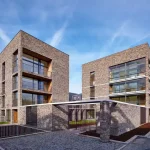Dalkeith Castle + Palace, Architect, Location, Building, Adam, Playfair, History
Dalkeith Palace, Midlothian : Castle + Estate
Historic Scottish House, nr Edinburgh, central Scotland
Dalkeith Castle
Location: Dalkeith, south-east of Edinburgh, Midlothian
Probably 12th century. Duchess of Buccleuch re-modelled the old Castle of Dalkeith from 1701, little changed since
History
Dalkeith Estate is an estate on the south-east edge of Edinburgh. Dalkeith has been in the Douglas and Scott family for almost 600 years. Dalkeith Castle originally belonged to the Grahams and was given to the Douglas family in the early 14th century. Cardinal Beaton was imprisoned in the Castle in 1543. The Castle was destroyed by the English in 1547.
James Douglas of Dalkeith became the 4th Earl of Morton in the mid-15th century: Dalkeith Castle became the Douglas stronghold and was fortified around 1575. King James VI visited the Palace in 1617. Many years later, the 8th Earl of Morton sold the Castle and Estate to King Charles I and the Policies became his hunting ground. Dalkeith Castle and grounds were resold to Morton and then again in 1642 to the 2nd Earl of Buccleuch.
The 2nd Earl of Buccleuch’s daughter married the Duke of Monmouth, eldest natural son of King Charles II: they became Duke and Duchess of Monmouth & Buccleuch. When the Duke of Monmouth died his widow, Anne, asked James Smith to use William of Orange’s Palace in Holland as a model for Dalkeith Palace. James Smith completed this large Scottish Country House in 1701-11: it was deemed the grandest of Scottish Classical Houses.
Buildings
John Adam (1762) and James Playfair (1786) made minor additions.
During the 1850′s the architects Bryce (David Bryce was Grand Architect for Scotland, a member of the Royal Scottish Academy) and Burn (William Burn, architect of Edinburgh’s Melville Monument) added the conservatory and church to Dalkeith Palace. The Laundry Cottages were restored and are occupied as offices by Scottish Natural Heritage and Edinburgh Green Belt Trust.
Dalkeith Palace additional buildings – David Bryce
Prince Charles Edward Stuart stayed two nights at Dalkeith Palace in 1745, King George IV slept here during his visit to Edinburgh in 1822 as did Queen Victoria in 1842.
Dalkeith Palace additional buildings – William Burn
Grounds
The Dalkeith Castle Grounds have been opened to the public since 1975. There are good walks around the grounds north east of Dalkeith and an adventure play area. Dalkeith Estate has some very high quality arable land let to tenants and some excellent examples of well managed broadleaved woodlands. Some of the ancient Caledonian Oak Forest can be seen in the Park between the rivers North and South Esk.
Dalkeith Castle : Folly
Today, the 9th Duke of Buccleuch resides at Bowhill, near Selkirk, in the Scottish Borders. Dalkeith Palace is leased to the University of Wisconsin as a base in Scotland. Dalkeith Palace has not been lived in by the Buccleuch family since 1914 and is now a European study centre for the University of Wisconsin USA, accommodating some 80 students at a time.
Please check with Dalkeith Palace for details such as access & charge
in Edinburgh & Lothian
Dalkeith Palace – 2004 Update
ARCADE won the competition for Dalkeith Palace Visitor Centre: to convert the existing south range of the Stables, originally designed by William Adam, to form a visitor centre for Dalkeith Country Park. ARCADE’s proposal also reinvigorated the Stables Courtyard using large-scale exhibits which visitors could interact with.
Visitor Centre at Dalkeith Palace Stables, Dalkeith Country Park, Midlothian, for Buccleuch Estates Ltd
Dalkeith Palace Stables architect – William Adam
Dalkeith Housing – find it on the Edinburgh Architecture website.
Castles in East Lothian
Historic Scottish Property Designs – key architectural selection below:
Lennoxlove House, south of Haddington, East Lothian
Lennoxlove House
Tantallon Castle, near North Berwick, East Lothian
Tantallon Castle
Dunbar Castle, East Lothian
Dunbar Castle
Historic Buildings in Eastern Scotland
Hailes Castle, east of Haddington, East Lothian
Hailes Castle
Comments / photos for the Dalkeith Castle Architecture page welcome
